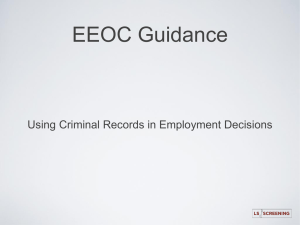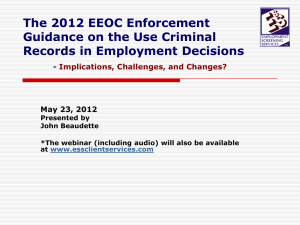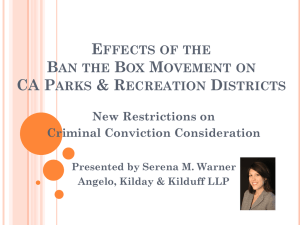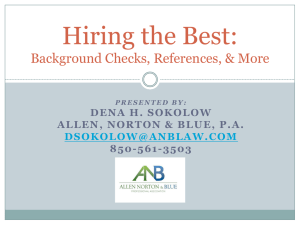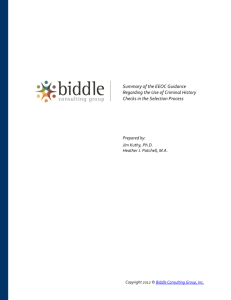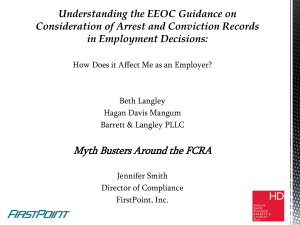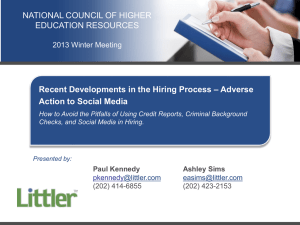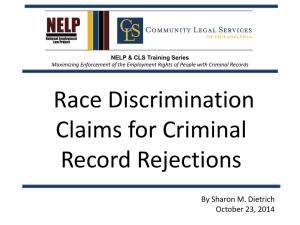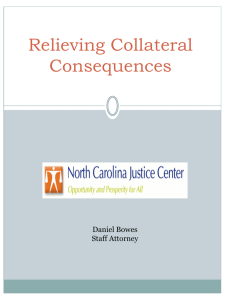What is a “Criminal Background Check”?
advertisement
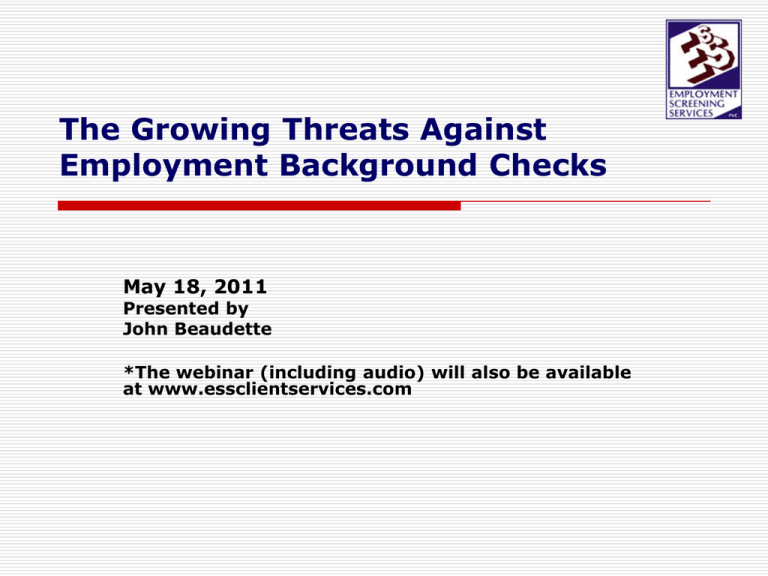
The Growing Threats Against Employment Background Checks May 18, 2011 Presented by John Beaudette *The webinar (including audio) will also be available at www.essclientservices.com ***OFFICIAL DISCLAIMER*** ESS Webinars and Presentations are presented for General Discussion Purposes Only. ESS does not provide legal advice and nothing presented or stated in ESS webinars, presentations, ESS websites, or by ESS personnel at this or any other time should be deemed or construed as legal guidance or legal opinion. You are urged to consult your legal department regarding your own situation and/or specific legal questions. Today’s Topics Employment Credit Report Restrictions Employer’s Use of Criminal Records Sample Criminal Record Policy/Matrix “Ban the Box” Initiatives Increase Quick Review of FCRA Adverse Action Employers’ Use of Credit Reports • 40% of employers do not use credit reports for any positions. • 47% of employers use credit reports for select positions • 91% for jobs with financial/fiduciary responsibilities 46% for senior executive positions 34% for positions with access to highly confidential information 13% of employers use credit reports for all positions. *SHRM member survey Questions to Consider Before Obtaining a Job Applicant’s Credit History 1. Is a credit report relevant to the position? What is the level of risk involved in the position? 2. At what point in the hiring process should a credit report be obtained? 3. How will I evaluate a credit report? Not all debt is created equal 4. How much weight should be given to a credit report? Should only be one factor 5. Do I understand the legal obligations ? Pre-adverse notification / Credit reports have errors Am I in a State that has specific restrictions? Considerations prior to running a credit report… State laws that restrict use of credit reports for employment purposes: • Hawaii – only when there is a conditional job offer and only when the employer can demonstrate a “directly related to a bona fide occupations qualification.” • Illinois -- • Maryland – unsupervised access to more than $2,500; signatory power over businesses assets of more than $100; management and control of the business; access to personal, financial or confidential information (10/10/2011) only when “bona fide purpose that is substantially job-related.” • Oregon - • Employer must disclose intent in writing to applicant “substantially job-related.” Employer must disclose intent in writing to applicant Washington - “substantially job-related.” Employer must disclose intent in writing to applicant A Few Myths about Employment Credit Reports… • An employer can obtain a credit report on a job applicant without the applicant ever knowing. • If an employer runs credit report, it will hurt the applicant’s credit score that potential lenders see. • An employer can get an applicant’s “credit score” like a lender. • An employer see an applicant’s age and marital status from a credit report. Criminal Record Checks by Employers Statistics Clarify the Problem • • Ex-offenders unable to get a job are three times as likely to return to prison, than those who find employment. One in four adults in the U.S. have a criminal record, or 64 million Americans. Nine million individuals release from prison each year. African Americans make up 13% of population, but account for 28.8% of arrests, and 55% of drug arrests (drug use – no ethnic, racial disparity) A disclosed criminal record reduces chance for a job call back by 50%; significantly higher for African American men. In 2010, 92% of SHRM members perform background checks – choice of over 800 screening services On-line federal, state repositories, and judicial information systems; commercial databases, nationwide network of county court researcher – accessibility continues to get better Equal Employment Opportunity Commission - Enforcement Agency of the Title VII of the Civil Rights Act of 1964 • EEOC – long known for taking action against overt, intentional discrimination based on race, gender, national origin and other protected categories. • EEOC now focusing on facially neutral selection criteria, such as credit reports and criminal records • Blanket Policy has Disparate Impact on minority groups Conviction constitutes reliable evidence, but still cannot be an absolute bar from employment. - Nature and gravity of the offense - Length of time since conviction/release - Nature of job sought/held EEOC’s E-RACE Initiative… E-RACE Initiative (Eradicating Racism and Colorism from Employment). By 2013, EEOC plans to: “Develop Strategies for Addressing 21st Century Manifestations of Discrimination.” “Implement investigative and litigation strategies to address selection criteria methods that may foster discrimination…such as credit and background checks, arrest and conviction records…” Individual Assessment of Conviction Data and a Reasoned Exercise behind Disqualification of Applicants with a Criminal History An Employment Screening Policy. Activist Group Finds No Shortage of Employers Advertising with “Blanket” Hiring Prohibitions National Employment Law Project (NELP) found the following job announcements: “Qualified candidates must be able to pass: Background Check (no felonies or misdemeanors)…” – Bank of America (600 clerical positions) “All Applicants must have a FULLY clean background for past seven years.” - Aramark (janitorial and food service positions) “We are looking for people who have spotless background/criminal history.” – CORT Furniture Rental “No arrests or convictions of any kind for past seven years. No felony convictions of any kind for life.” – OMNI Energy Services Corp. “Applicants must also pass a background check investigation showing no felony convictions.” Domino’s Pizza “You must not have any felony or misdemeanor convictions on your record.” – Crown Services Inc. “All candidates must consent to a drug test and criminal background check (no felonies or misdemeanors allowed). -- Peak Organization “Openly Exclusionary no-hire bans are commonplace. That employers and staffing firms continue to post such ads notwithstanding the 20-plus year-old Title VII guidance issued by the EEOC suggests that even the national largest employers are either unaware of civil rights and consumer protections for people with criminal records or are indifferent to them.” – NELP March 2011 Lawsuits or EEOC Petitions in Progress… • • • • • • • Radio Shack/Choice Point – automatically rejected on-line applicants who marked “yes” to felony record in last 7 years. Accenture – rejects applicants and terminates employees with criminal records regardless of fitness or ability to perform the job First Transit Inc. – hires no one with a felony or served any time in jail Burlington Northern Santa Fe RR – no felony convictions in the past seven years Lowes – Applicant for garden center attendant had 1999 felony drug conviction; never convicted of any other offense; strong work history. 2009 he filed title VII charges with EEOC against Lowes US Census Bureau – roughly 700,000 people with criminal record automatically disqualified ABM Industries obtained background checks with dismissed charges, against state law EEOC v. Peoplemark – an EEOC Misstep In 2008, the EEOC alleged Peoplemark had a Blanket Policy which denied the hiring of or employment of any person with a criminal record. - Disparate Impact Against African Americans - Violation of Title VII of Civil Rights Act The Problem? - Peoplemark had no such policy - Peoplemark had hired individuals with a criminal record On March 31, 2011, the judge through out the case and chastised the EEOC for spending years and tax pay dollars on an assertion they knew or should have known was not true - Ordered EEOC to pay Peoplemark $751,942 in legal fees What does the research show about the relationship between persons with a criminal record and job performance job relatedness? Blumstein and Nakamura Study • Took a large sample of 18-21 year-olds in New York in 1980 who had been arrested for either Burglary, Aggravated Assault or Robbery and tracked them over time. • Compared criminal histories to general population. Authors found that 18 year-olds • • • 3.8 years after being arrested for Burglary have the same risk of being arrested as the general population. 4.3 years after being arrested for Aggravated Assault have the same risk of being arrested as the general population. 7.7 years, after being arrested for Robbery have the same risk of being arrested as the general population. Conclusions – • • • The probability of ex-offender re-offending diminishes the longer he/she stays law-abiding. The older the offender, the less time it takes to have the same arrest rate as the general population The probability of committing an offense involving the work place even more remote. Sample Background Check Policy and Decision Matrix Available at www.essclientservices. com The Aspirations of “Ban the Box” Initiatives… By requiring employers to not ask about applicant criminal histories on the initial employment application, advocates hope – • Removes the deterrence of ex-offenders from even applying • Deters the employer from “sifting out” ex-offenders • Gives the ex-offender a chance to demonstrate qualifications, skills, experience • When a record is disclosed/found, forces the employer to take a closer look at job relevance, time elapsed, seriousness of offense, evidence of rehabilitation, other mitigating factors Advocates hope federal and state government “ban the box” policies will become a model to private employers and cause them to see the discrimination against ex-offenders as “invidious and unreasonable.” *”Ban the Box to Promote Ex-offender Employment” (2007) Henry and Jacobs “Ban the Box” Initiatives Increase States and cities with current “Ban the Box” laws on the books: Hawaii – state law prohibits employers from asking about convictions until after a conditional job offer Massachusetts – state law prohibits employers from asking about “criminal offender record information” Various City and County Governments – CA, CT, FL, IL, MD, MA, MN, NM, NY, OH, PA, RI, TN, TX, WA, WI (most apply only to the public sector at this time) “The only harm that I see the potential employers may encounter is the time and money spent reading an application and interviewing an individual," she said. "This legislation does not force the employer to hire or take away their ability to judge the potential employee based on their criminal records” -Philadelphia Councilwomen Donna Reed Miller (04/19/2011) Quick Review of FCRA Adverse Action Steps NELP contends that the failure of screening firms and employers to provide “pre-adverse-action” notices mirrors the upsurge in Title VII litigation. Step One: Pre-Adverse Action Letter (before adverse action is taken) Pre-Adverse Action Letter (requires certain language) A copy of the report Summary or Your Rights Under The Fair Credit Reporting Act <Wait a reasonable period for the applicant/employee to receive the letter and have the opportunity to dispute or explain information on the report.> Step Two: Adverse Action Letter (adverse action is taken) Adverse Action Letter (requires certain language) Summary or Your Rights Under The Fair Credit Reporting Act *Letters and FTC Summary are available at www.essclientservices.com or email christie@employscreen.com for an “Adverse Action Kit.” ESS can process your adverse actions for you; make the request to adverseaction@employscreen.com, or form the IRAS web site. Other Challenges… • ABA committee recommendations to automatically seal misdemeanor and felony convictions after passage of specified period of law-abiding conduct. • Effective July 1, 2011, drug offenders in Colorado, after 3-10 years of law-abiding behavior may petition the court to seal the record. • Continually laws introduced to states and counties to redact identifiers from criminal indexes Questions? If you have any questions or would like to get in touch with me, please feel free to contact me at: johnb@employscreen.com 1-800-473-7778 x 101 *The webinar (including audio) will be available soon at www.essclientservices.com
